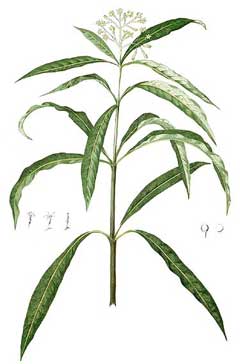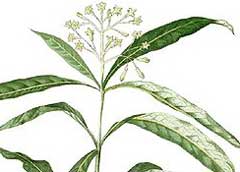 |
|
http://commons.wikimedia.org/wiki/File:Skimmia_laureola_Blanco1.128-cropped.jpg |
 |
|
Translate this page:
Summary
Physical Characteristics

 Skimmia laureola is an evergreen Shrub growing to 1.5 m (5ft).
Skimmia laureola is an evergreen Shrub growing to 1.5 m (5ft).
See above for USDA hardiness. It is hardy to UK zone 7 and is not frost tender. It is in leaf all year, in flower from April to June. The species is dioecious (individual flowers are either male or female, but only one sex is to be found on any one plant so both male and female plants must be grown if seed is required). . The plant is not self-fertile.
Suitable for: light (sandy), medium (loamy) and heavy (clay) soils and prefers well-drained soil. Suitable pH: mildly acid, neutral and basic (mildly alkaline) soils. It can grow in semi-shade (light woodland) or no shade. It prefers moist soil. It can tolerate atmospheric pollution.
UK Hardiness Map
US Hardiness Map
Synonyms
S. melanocarpa. Reh.&Wils. Limonia laureola.
Plant Habitats
Woodland Garden Dappled Shade; Shady Edge; Ground Cover;
Edible Uses
Edible Parts: Leaves
Edible Uses: Condiment
Leaves - cooked. Used as a condiment[272]. The strongly aromatic leaves are used in curries or as a flavouring for other foods[146, 177, 183].
References More on Edible Uses
Medicinal Uses
Plants For A Future can not take any responsibility for any adverse effects from the use of plants. Always seek advice from a professional before using a plant medicinally.
The leaves are used in the treatment of smallpox[240]. The smoke produced by burning them is said to purify the air[240].
References More on Medicinal Uses
The Bookshop: Edible Plant Books
Our Latest books on Perennial Plants For Food Forests and Permaculture Gardens in paperback or digital formats.

Edible Tropical Plants
Food Forest Plants for Hotter Conditions: 250+ Plants For Tropical Food Forests & Permaculture Gardens.
More

Edible Temperate Plants
Plants for Your Food Forest: 500 Plants for Temperate Food Forests & Permaculture Gardens.
More

More Books
PFAF have eight books available in paperback and digital formats. Browse the shop for more information.
Shop Now
Other Uses
Essential Incense Wood
An essential oil in the leaves is used in scenting soap[61, 240, 272]. The dried leaves are used as an incense[61, 145, 211]. The fresh leaves are used to make garlands for weddings[211]. Plants can be grown as a ground cover when planted about 1 metre apart each way[208]. Wod - used to make handles of small farming implements such as hoes and axes[272].
Special Uses
Ground cover Scented Plants
References More on Other Uses
Cultivation details
Succeeds in a well-drained open loam or in a peaty soil in a sunny position[1]. Probably flowers well in the shade[11]. Plants are very tolerant of atmospheric pollution, being unharmed by deposits of soot or a sulphur-laden atmosphere[245]. This species is not very frost-hardy and so is rather tender in much of Britain[1]. The flowers are sweetly scented[184]. The small yellow flowers are oppressively scented, giving a somewhat unpleasant smell near to, though agreeable at a distance[245]. The bruised leaves are strongly aromatic[245]. The plant is superficially similar to Daphne cannabina and is often mistaken for that species[211]. Dioecious. Male and female plants must be grown if seed is required.
References Carbon Farming Information and Carbon Sequestration Information
Temperature Converter
Type a value in the Celsius field to convert the value to Fahrenheit:
Fahrenheit:
The PFAF Bookshop
Plants For A Future have a number of books available in paperback and digital form. Book titles include Edible Plants, Edible Perennials, Edible Trees,Edible Shrubs, Woodland Gardening, and Temperate Food Forest Plants. Our new book is Food Forest Plants For Hotter Conditions (Tropical and Sub-Tropical).
Shop Now
Plant Propagation
Seed - can be sown as soon as it is ripe in a cold frame[K]. It also succeeds when sown in early spring. When they are large enough to handle, prick the seedlings out into individual pots and grow them on in a shady position in the cold frame for at least their first winter. Plant them out into their permanent positions in late spring or early summer, after the last expected frosts. If there is sufficient seed then it can be sown can be in an outdoor seedbed in early spring[200]. Grow the plants on in the seedbed for a couple of years before planting them out in late autumn or early spring. Cuttings of half-ripe wood, July/August in a cold frame[11]. Cuttings of nearly mature side shoots, 7 - 10cm with a heel, September in a cold frame. Slow to root, they should be left for 18 months before moving to their permanent positions. Good percentage[78]. Layering in autumn. Takes 18 months. Good to high percentage[78].
Other Names
If available other names are mentioned here
Native Range
TEMPERATE ASIA: China (Xizang Zizhiqu (south)) TROPICAL ASIA: Bhutan, India (Arunachal Pradesh, Nagaland, West Bengal, Manipur, Sikkim), Nepal
Weed Potential
Right plant wrong place. We are currently updating this section.
Please note that a plant may be invasive in one area but may not in your area so it's worth checking.
Conservation Status
IUCN Red List of Threatened Plants Status :

Growth: S = slow M = medium F = fast. Soil: L = light (sandy) M = medium H = heavy (clay). pH: A = acid N = neutral B = basic (alkaline). Shade: F = full shade S = semi-shade N = no shade. Moisture: D = dry M = Moist We = wet Wa = water.
Now available:
Food Forest Plants for Mediterranean Conditions
350+ Perennial Plants For Mediterranean and Drier Food Forests and Permaculture Gardens.
[Paperback and eBook]
This is the third in Plants For A Future's series of plant guides for food forests tailored to
specific climate zones. Following volumes on temperate and tropical ecosystems, this book focuses
on species suited to Mediterranean conditions—regions with hot, dry summers and cool, wet winters,
often facing the added challenge of climate change.
Read More
Expert comment
Author
(DC.)Siebold.&Zucc. ex Walp.
Botanical References
1151200
Links / References
For a list of references used on this page please go here
Readers comment